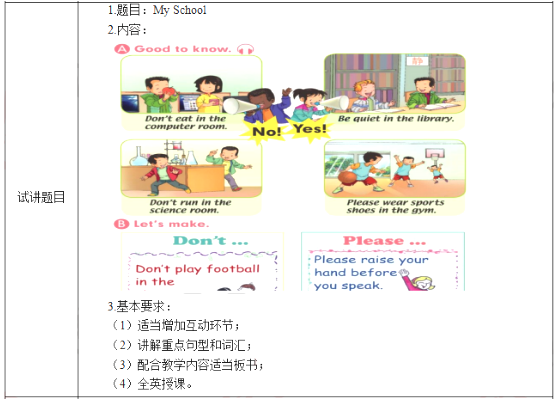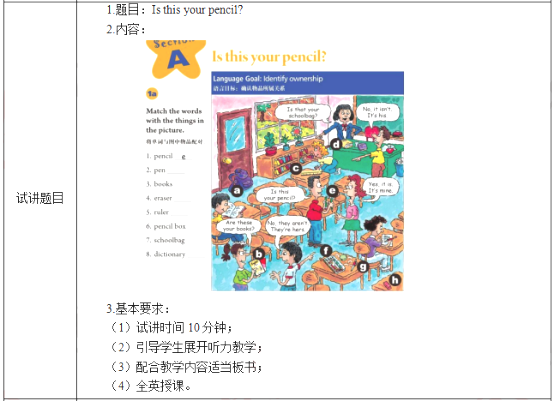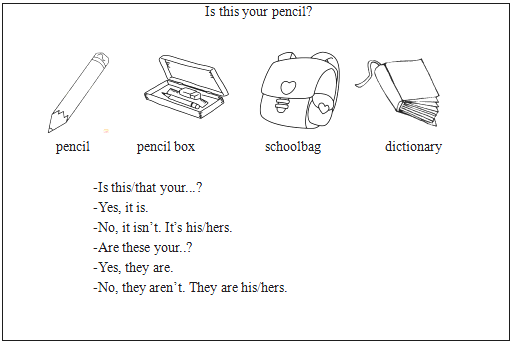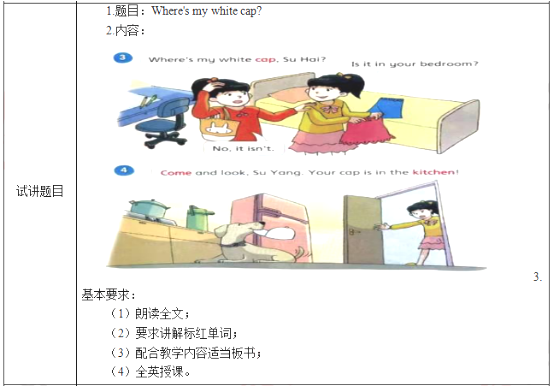一、考題回顧

【教案】
My School
Teaching aims:
Knowledge aims:
Students can master the usage of some sentence structure, such as “Don’t...” “ Please...”.
Students can understand the general idea of the conversation.
Ability aims:
Students’ listening and speaking abilities can be greatly upgraded.
Students can talk about what they should do and shouldn’t do correctly.
Emotional aims:
Students can foster their awareness of obeying rules and regulations.
Students will be more polite in their daily life.
Key and difficult points:
Key point:
To master the usage of some sentence structure, such as “Don’t...” “Please...”.
Difficult point:
How to talk about what they should do and shouldn’t do correctly.
Teaching procedures:
Step 1: Warming-up
1. Greetings.
2. Sing a song named London Bridge for students and ask students to sing together with me.
London Bridge is falling down
falling down, falling down
London Bridge is falling down
My fair lady
3. Have a free talk and ask students a question:
“If you travel to London, what will you do?”
Invite students to share their opinions and tell them there are various things they should do and shouldn’t do in their daily life. Lead in the topic of this lesson.
Step 2: Presentation
1. Show some pictures of different buildings at school and invite students to review the words they have learned, such as “computer room”, “ library”, “science room” and “gym”.
2. Present a video of misbehavior in the class and ask students what’s wrong in the video. Teach them key structure “Don’t...” “Please...” through questions and guidance.
Present some pictures and help students to understand “Don’t eat in the computer room.” “Don’t run in the science room.” “Please be quiet in the library.” “Please wear sports shoes in the gym.”
Step 3: Practice
Play a game called Flash card together with students to consolidate the structure. I show the pictures and students speak out the orders correspondingly.
Step 4: Production
Discussion
Ask students to do a discussion in groups of 4 within 5 minutes and ask their group members about what other rules they know in their daily life. Draw some pictures and write the rules down. Later, invite some representatives to have a presentation in front of the whole class. Positive evaluation will be given to them.
Step 5: Summary and Homework
Summary: invite a student to be a little teacher and summarize today’s lesson. Ask students to respect and obey rules in their daily life.
Homework: ask students to tell their parents about what they have learned in this class and design a poster in groups calling for obeying rules.
Blackboard design:

Teaching reflection
一、考題回顧

【教案】
Is this your pencil?
Teaching aims:
Knowledge aims:
Students can understand the content of the listening material.
Students can be familiar with the new words and the expression about ownership.
Ability aims:
Students will develop their listening abilities of catching key words.
Students can identify the ownership in their daily life.
Emotional aims:
Students will cooperate with other group mates to complete the tasks together.
Students can foster the interest and desire of learning English, and be fond of taking part in group activities.
Key and difficult points:
Key point:
To master the key words and sentence structures.
To get to know the main content of the listening material.
Difficult point:
To improve their awareness of the importance of communication and cooperation.
To use different basic listening strategies like extensive listening and intensive listening in their listening process.
Teaching procedures:
Step 1: Warming-up
1. Greetings.
2. Let students enjoy a song named What's This. Then ask them what they heard from the song. The song goes like this:
What's this? What's this? What's this?
What?what?
It's a hat. It's a hat. It's a hat hat hat
What's this? What's this? What's this?
What?what?
It's a bat. It's a bat. It's a bat bat bat
What's this? What's this? What's this?
What?what?
It's a pen. It's a pen. It's a pen pen pen
What's this? What's this? What's this?
What?what?
It's a pencil. It's a pencil. It's a pencil pencil pencil.
Ask students to answer the question. Then tell them that it is related to today’s topic and lead in this class.
Step 2: Pre-listening
Draw some stick figures about the new words: “pencil”, “pencil”, “box”, “schoolbag”, and “dictionary” on the blackboard. Ask students to look at the pictures and teach them two new words. And students will be invited to read these words by playing a game-High and Low Voice. If the teacher read the words in high voice, students should read them in low voice and vice verse.
Present sentence patterns “Is this/that your..” “Yes, it is.” “No, it isn’t. It’s his/hers.” “Are these your..?” “Yes, they are.” “No, they aren’t. They are his/hers.”
Step 3: While-listening
1. Extensive listening
Ask students to listen to the tape and answer the following questions of the listening material.
Q1: How many things have been mentioned in the dialogue?
Q2: How many people in the dialogue?
Then invite one student to write the answer on the blackboard.
2. Intensive listening
Play the tape again and ask students to answer the following questions and do a match on the screen.
Q1: Is this Tom’ s pencil?
Q2: Is this Anna’ s schoolbag?
Q3: Is this Lucy’ s pencil box?
Q4: Is this Linda’ s dictionary?
Q5: Are these Mary’s books?
Step 4: Post-listening
Students will be given 5 minutes to make a new dialogue with their desk-mates. They are required to use the sentence structures. One asks question “Is this your ...”, and the other answers “Yes, it is./ No, it isn’t.”.
Step 5: Summary and Homework
Summary: invite a student to be a little teacher and summarize today’s lesson.
Homework: ask students to read the conversation to their parents and draw a picture about new words and ask their parents “Is this your ...”.
Blackboard design:

Teaching reflection
一、考題回顧

【教案】
Where's my white cap?
Teaching aims:
Knowledge aims:
Students can understand the content of the listening material.
Students can be familiar with the new words such as"cap" "come"and so on.
Ability aim:
Students will develop their listening abilities of catching key words.
Emotional aim:
Students can be more interested in English and have more confidence in learning English.
Key and difficult points:
Key point:
How to understand the listening material and key words.
Difficult point:
How to be more interested in English and have more confidence in learning English.
Teaching procedures:
Step 1: Warming-up
1. Greetings.
2. Let students enjoy a song named Getting Dressed Song and ask them to sing together. The song goes like this:
I am learning to get dressed,
I’ m learning what to do!
This is how I put on my shirt,
This is how I pull on my trousers,
This is how I pull up my socks,
This is how I slip on my shoes!
Ask students to answer the question "How many clothes did you hear just now". Then tell them that today they will learn something about dressing and lead in the topic.
Step 2: Pre-listening
Show students some clothes to present some words about clothes such as “cap” “coat” and son on and lead in the sentence pattern “Where is...?” “It’s in/on...”
Do an action to express "come" “go”
Show students a picture of a house, let students understand the meaning of some words about rooms such as “living room” “kitchen” and introduce the structure “Is it in/on...?” “Yes, it is./No, it isn’t.”
Step 3: While-listening
1. Extensive listening
Read the passage for students and ask them to find how many people are there in the listening material.
Then invite one student to answer the question.
2. Intensive listening
Play the tape and ask students to answer two questions:
Q1: Whose white hat is lost?
Q2: Where is the white hat?
Then write these two questions on the blackboard. And tell students when they want to ask if something is in a certain location, they can use "Is it in...?", and the positive response is "Yes, it is.", the negative response is "No, it isn't."
Step 4: Post-listening
Ask students to have a dialogue with their deskmates, one imagine something's location, and the other should guess where it is. 5 minutes are given for preparation. Then invite some groups to share.
Step 5: Summary and Homework
Summary: invite a student to be a little teacher and summarize today’s lesson. Ask students to take good care of their belongings.
Homework: ask students to design a poster of their room.
Blackboard design:

Teaching reflection
下載233網校APP,可方便及時獲取小學英語教師資格證面試真題。

真題推薦:歷年教師資格證面試真題>>>
教師資格證面試如何快速通關?233網校還原面試情景現場,助你一舉攻下“結構化面試+試講+答辯”三大內容,實戰通關!試聽課程>>
答疑解惑:添加小編微信個人號【ks233wx3】,或關注微信公眾號【jiaoshi_233】搜索微信公眾號“233網校教師資格證考試”,關注即可一對一答疑解惑!

